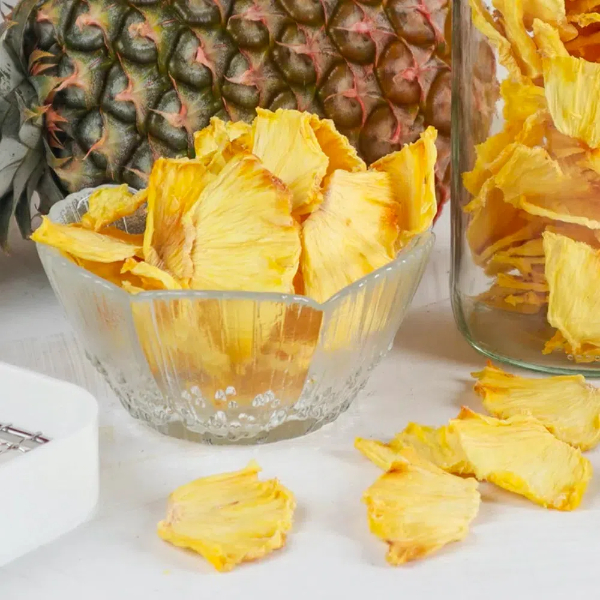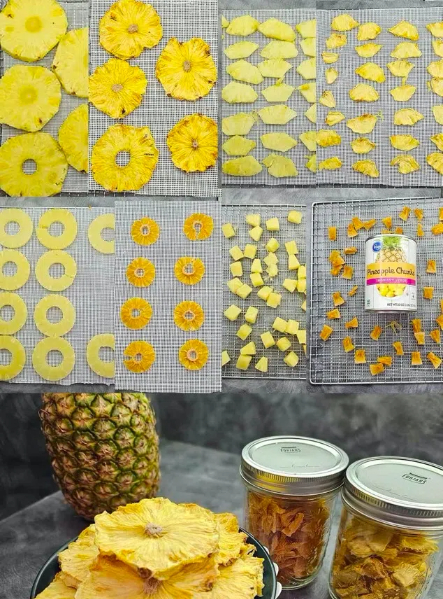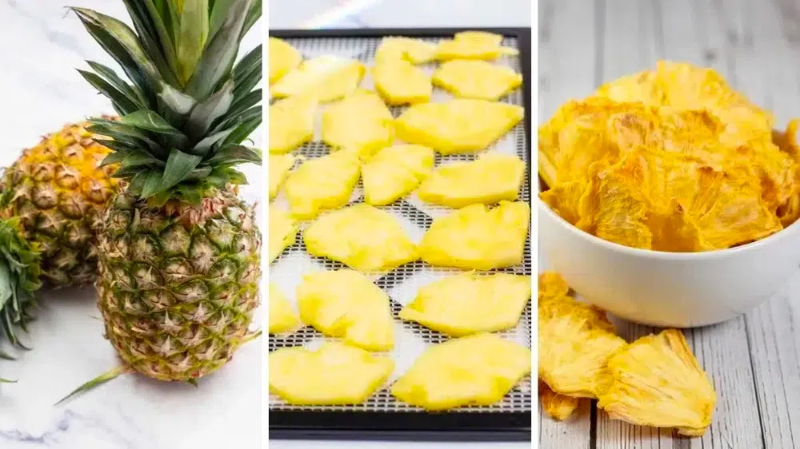
Content Menu
● Why Use a Food Dehydrator?
● Preparing Pineapple for Dehydration
● Dehydration Process
● Cooling and Storing Dried Pineapple
● Uses for Dried Pineapple
● Tips for Successful Dehydration
● Troubleshooting Common Issues
● Conclusion
● FAQ
>> 1. How do I know when my dried pineapple is ready?
>> 2. Can I dehydrate canned or frozen pineapple?
>> 3. What temperature should I use for dehydrating pineapple?
>> 4. How long does it take to dehydrate pineapple?
>> 5. How should I store dried pineapple?
● Citations:
Dehydrating pineapple is a fantastic way to preserve this delicious fruit while intensifying its natural sweetness. Using a food dehydrator not only makes the process easier but also ensures consistent results. In this guide, we will explore the step-by-step process of drying pineapple, including preparation, dehydration times, and storage tips.

Why Use a Food Dehydrator?
A food dehydrator is an appliance designed to remove moisture from food, which helps to extend its shelf life without the need for preservatives. Here are some benefits of using a dehydrator:
- Consistent Temperature: Dehydrators maintain a steady temperature, which is crucial for even drying.
- Multiple Trays: Most dehydrators come with multiple trays, allowing you to dry large quantities of fruit at once.
- Energy Efficient: Compared to using an oven, dehydrators consume less energy and can run for longer periods without overheating.
Preparing Pineapple for Dehydration
Before you begin the dehydration process, proper preparation of the pineapple is essential. Follow these steps:
1. Select a Ripe Pineapple: Choose a pineapple that is ripe but not overripe. Look for a sweet aroma and firm texture.
2. Wash the Pineapple: Rinse the outside of the pineapple under cold water to remove any dirt or pesticides.
3. Cutting the Pineapple:
- Cut off the top and bottom of the pineapple.
- Stand the pineapple upright and slice off the skin, ensuring you remove all "eyes."
- Cut the pineapple into uniform pieces (about 1/4 inch thick) for even drying. You can make rings or chunks based on your preference.
Dehydration Process
Now that your pineapple is prepared, it's time to dehydrate it using your food dehydrator.
1. Arrange on Trays: Lay the pineapple pieces on the dehydrator trays in a single layer, ensuring they are not touching to allow for proper air circulation.
2. Set Temperature: Set your dehydrator to 135°F (57°C). This temperature is ideal for drying fruits without cooking them.
3. Drying Time: The dehydration process will typically take between 10 to 18 hours, depending on:
- The thickness of your slices
- The juiciness of the pineapple
- The humidity level in your environment
4. Check for Doneness: Pineapple is done when it feels leathery but still pliable. If it feels sticky or moist in any area, it needs more time in the dehydrator.
5. Rotate Trays (if necessary): Some dehydrators may require you to rotate trays every few hours for even drying.

Cooling and Storing Dried Pineapple
Once your pineapple is fully dehydrated:
1. Cool Down: Allow the dried pineapple to cool on the trays for about 30 minutes before storing.
2. Conditioning: To ensure even moisture distribution, place cooled pieces in an airtight container for about a week. Shake daily to check for moisture accumulation.
3. Storage: Store dried pineapple in airtight containers or vacuum-sealed bags in a cool, dark place. Properly dried and stored pineapple can last up to a year.
Uses for Dried Pineapple
Dried pineapple can be used in various ways:
- Snacking: Enjoy it as a healthy snack on its own.
- Trail Mix: Add dried pineapple to your favorite trail mix combinations.
- Baking: Incorporate it into muffins, breads, or granola bars.
- Cooking: Use rehydrated pineapple in savory dishes like stir-fries or salads.
Tips for Successful Dehydration
To enhance your experience and ensure successful dehydration of pineapple, consider these additional tips:
- Uniformity is Key: Ensure all pieces are cut to similar sizes for even drying. Thicker pieces will take longer than thinner ones.
- Use Lemon Juice: Soaking fresh pineapple slices in lemon juice before dehydration can help prevent browning and enhance flavor.
- Avoid Overloading Trays: Do not overcrowd your dehydrator trays; this can lead to uneven drying and longer dehydration times.
- Monitor Humidity Levels: If you live in a humid environment, consider using a dehumidifier in the room where you're dehydrating to improve results.
Troubleshooting Common Issues
Even experienced users may encounter issues when dehydrating food. Here are some common problems and solutions:
- Moisture Retention: If your dried pineapple feels sticky or moist after cooling, it may not have been dried long enough. Return it to the dehydrator until fully dry.
- Uneven Drying: If some pieces are drier than others, ensure that all pieces are cut uniformly and consider rotating trays during the drying process.
- Loss of Flavor or Color: To preserve flavor and color better, consider pretreating with ascorbic acid or citric acid before dehydration.
Conclusion
Dehydrating pineapple at home using a food dehydrator is an easy and rewarding process that allows you to enjoy this tropical fruit year-round. With just a few simple steps, you can create delicious snacks that are perfect for any occasion. By following this guide and applying tips from experienced users, you'll be well on your way to mastering the art of food dehydration.

FAQ
1. How do I know when my dried pineapple is ready?
The dried pineapple should be leathery but still pliable without any sticky spots. If it feels moist or sticky, it needs more time in the dehydrator.
2. Can I dehydrate canned or frozen pineapple?
Yes! For canned pineapple, drain it well before drying. For frozen pineapple, thaw it slightly and then proceed with the dehydration process as usual.
3. What temperature should I use for dehydrating pineapple?
Set your food dehydrator to 135°F (57°C) for optimal results when drying pineapple.
4. How long does it take to dehydrate pineapple?
Dehydration can take anywhere from 10 to 18 hours depending on slice thickness and humidity levels in your environment.
5. How should I store dried pineapple?
Store dried pineapple in airtight containers or vacuum-sealed bags in a cool, dark place to maximize shelf life.
Citations:
[1] https://www.freshoffthegrid.com/dehydrating-pineapple/
[2] https://www.backpackingchef.com/dehydrating-food.html
[3] https://www.gettystewart.com/how-to-dehydrate-pineapple-fresh-frozen-or-canned/
[4] https://flouronmyface.com/dehydrated-pineapple/
[5] https://extension.psu.edu/lets-preserve-drying-fruits-and-vegetables-dehydration
[6] https://homegrownhappiness.com/dehydrated-pineapple/
[7] https://dailydish.co.uk/dehydrated-pineapple-how-to-dry-pineapple/
[8] https://omadarling.com/how-to-dehydrate-fruit/
[9] https://www.rebootedmom.com/how-to-dehydrate-pineapple/
[10] https://www.cravethegood.com/how-to-dehydrate-pineapple/
[11] https://practicalselfreliance.com/dehydrating-pineapple/
[12] https://homesteadingfamily.com/preservation-101-intro-to-dehydrating-food/
[13] https://www.thepurposefulpantry.com/dehydrate-pineapple/
[14] https://www.theseasonalhomestead.com/food-dehydration-101-drying-fruits-and-vegetables/
[15] https://www.youtube.com/watch?v=gvuPpZuzMG4
[16] https://blog.lemproducts.com/best-dehydrating-practices/
[17] https://winecountrytable.com/eat-drink/chefs-tips/the-art-of-dehydrating-fruit-vegetables-and-herbs-a-chefs-guide/
[18] https://sproutingzen.com/dehydrated-pineapple-chunks-recipe/
[19] https://www.dehydratorsamerica.com/post/best-practice-for-drying-fruit-and-vegetables-commercial-dehydrators











